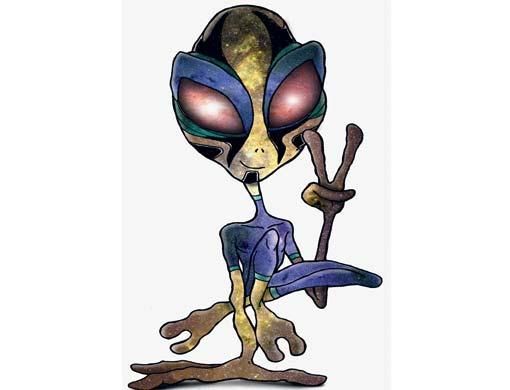A decade ago, my question about ET would have been greeted with nervous laughter, curling toes or embarrassed silence. Perhaps even a contemptuous sneer.
So it was extraordinary to find myself sitting before a respected huddle of planet hunters with the Britain's Science Minister, Malcolm Wicks, recently as they declared they believe in aliens.
Seven leading British experts were briefing the minister in a session entitled "Is there life out there? - Other Earth-like or habitable planets" in the bowels of the Department of Trade and Industry, when I put to them two questions: is there alien life? And if there is, do you think it is intelligent?
Until recently, the assembled scientists would (quite rightly) have pointed out that there is no universally accepted definition of life, let alone of intelligence. Any talk of smart extraterrestrials belonged in science fiction.
Today, our understanding of the cosmos has changed so much that for the first time searching for signs of life in other solar systems is not just a philosopher's dream but on the list of planned human endeavours.
All the scientists I questioned agreed that alien life is inevitable and ubiquitous. And all but one believe it could be intelligent - ie with the faculty of reasoning and understanding
Some even think we will find some form of life on our doorstep. Prof John Zarnecki of The Open University bullishly told the minister: "My position is very simple. We will find extinct or some life in the solar system."
He believes primitive bugs, or their remains, will be found in 2015 when a European Space Agency mission will land on Mars to dig into its dusty red surface. After all, once upon a time Mars was a warmer, wetter and more comfortable place.
And he has high hopes for a future mission to the icy moon Europa, the heart of which is warmed by tidal forces as it orbits Jupiter. "We shall find life on Europa in 2023," he told us with determination.
Why so confident? Our own planet proves that life can flourish quickly. The first creatures evolved on primordial Earth with indecent haste, only half a billion years or so after its birth 4.5 billion years ago, and microbes have now been found in the most inhospitable nooks and crannies, able to dine on wet rock or thrive without sunshine.
This prompted Dr Ian Stevens of the University of Birmingham to speculate that other planets must support life, too: "My guess is life is common out there." But it is the discovery of almost 300 worlds orbiting distant stars that has excited experts the most.
Their rising confidence that the conditions might exist somewhere for the development of intelligent alien life comes from their conviction that they will find many Earth-like planets that are in what they call the "Goldilocks zone" (where conditions on the planet are not too hot and not too cold but "just right", so that liquid water is present and life could evolve).
Formidable challenges
There are formidable challenges facing planet hunters given the vastness of our cosmos. The most distant man-made object is Voyager 1, launched 30 years ago and now around 10 billion miles away.
While it takes light a day to travel from the aged probe to Earth, the glow of the nearest star takes four years, while the light from most stars we can see at night takes hundreds, or even thousands of years to reach us.
Spotting a planet in orbit around these points of light is a daunting task, likened to detecting the glow of a lighthouse keeper's cigarette from miles away when the beam of his lighthouse is shining directly at you.
But in 1992, scientists realised that it was possible to find distant worlds when Alexander Wolszczan of Pennsylvania State University found a planet orbiting a neutron star (the remnant of a stellar explosion). Of all the places that astronomers expected to find alien planets, this was not one of them.
"It was a ridiculous place to have a planet," said Dr Stevens. "But it was there." Three years later, a team working at the Geneva Observatory in Switzerland made headlines worldwide when they found something like our own solar system, a planet orbiting an alien sun called 51 Pegasi.
Planet hunters rely on measurements of exquisite precision to find alien worlds. They search for the minute effects of an orbiting body on its parent star - a drop in brightness as the planet passes in front (the transit method), or a tiny shift in starlight, caused by a wobble in the star's position as it is tugged by the gravitational pull of its planet.
The effects are subtle: our own Sun moves at a baby's crawl in response to the gravity of the Earth as it zips around at 67,000 miles per hour.
The CoRot (pronounced "Coreau'') mission blasted off last December carrying the first telescope capable of finding rocky planets only a few times the size of the Earth around sun-like stars using the transit method.
To detect such a planet, the one-foot telescope would have to register a tiny dimming lasting a few hours, every time the planet goes around the star, said Dr Suzanne Aigrain of the University of Exeter.
It will take more sophisticated space telescopes (planned in the next decade) to reveal an Earth-like twin with oxygen and liquid water, but CoRot is expected to show where to look for one within months.
In about 15 years, a European Space Agency mission called Darwin will send a flotilla of telescopes above our turbulent atmosphere to scan 500 stars within a distance of 60 light years from us, then study 50 alien planets to seek signs of life, in the form of bacteria, plants or animals.
Prof Glenn White, of The Open University and Rutherford Appleton lab, said: "We are pretty sure that we will have an extremely high probability of telling you whether life has started on a planet. By around 2020 we will have very definitive answers."
Dr Michael Perryman, of the European Space Agency, added that even now it is possible to analyse light from an alien planet, "which is staggering".
Seeing abundant oxygen would be encouraging, since oxygen reacts rapidly and gets destroyed. If found with other gases, notably ozone, nitrous oxide and methane, it would suggest a "biosphere" teeming with creatures.
Although he was the only scientist present who doubted there was intelligent alien life, arguing that Earth's circumstances are too special to be replicated, Dr Perryman said he would not be surprised if biologists soon reported signatures that hinted at habitable planets.
What kind of life do we expect? The smart money is on most aliens being microbes. But no one can rule out the possibility of higher life forms.
Or that they could thrive in pools of liquid methane, on dry dusty worlds, be silicon based, or even waft about as organised clouds.
What should we do if we detect a message from an alien? "This will have profound consequences for how we see ourselves," says Prof Keith Mason, chief executive, Science and Technology Facilities Council.
The news will not reach the public until a process of verification and approval is exhausted, in the best tradition of earthly bureaucracy.
Leaks to the press seem likely, given the Byzantine notification process in the 1989 "Declaration of Principles Concerning Activities Following the Detection of Extraterrestrial Intelligence".
But all this talk of what we will do is very one sided. Dr Perryman told the minister that aliens could now be eavesdropping on our radio and television. "As from 1927, we have been propagating outwards from Earth, a very specific indicator of our existence."
These radio waves have since travelled 80 light years out into the universe. "That is going to encompass many hundreds of potentially habitable planets," he said. "If there is intelligent life out there, they sure as hell know we are here."










